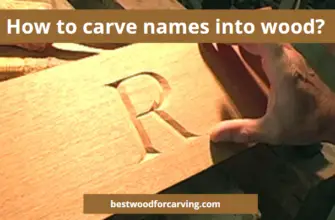How to use a countersink bit? Welcome to my woodworking haven, where today we delve into the art of countersinking with the trusty countersink bits. In this post, I will provide crucial tips and teach you how to use a countersink bit.
![How to Use a Countersink Bit? [A 10-Step Guide] bestwoodforcarving 43](https://bestwoodforcarving.com/wp-content/uploads/2024/01/bestwoodforcarving-43.jpg)
- Countersink Bit 101
- Countersink Screws
- Countersink Screw Head
- Countersink Hole
- Countersink Drill Bit – Choosing the Right Fit
- 1. Ensure the Size of a Drill Bit is Right
- 2. Drill Slowly and Methodically
- 3. Assess the Wood’s Surface
- Step-by-Step Guide to Countersinking Screws
- 1. Prepare Your Materials
- 2. Select the Right Countersink Bit
- 3. Make a Pilot Hole
- 4. Insert the Countersink Bit
- 5. Fine-tune the Depth:
- 6. Begin Countersinking:
- 7. Check for Protruding Screws:
- 8. Use a Hex Wrench if Necessary:
- 9. Hide Countersink Screws:
- 10. Screw Slowly for Precision:
- Pilot Holes in Countersinking
- Guiding Countersink Screws
- Make a hole deep enough
- Minimizing Splintering and Wood Damage
- Enabling Precise Placement of Countersink Holes
- FAQs
- What do you use a countersink bit for?
- Do you drill before or after countersink?
- What is the general rule of countersink?
- How do you use a countersink in wood?
- Takeaways
Countersink Bit 101
Countersink drill bits serve an essential role in various construction projects. Countersink drill bits drill holes in different materials, facilitating the embedding of screws.
In addition to woodworking and construction, countersink drill bits find widespread utility in metalworking projects.
Typically, countersink bits feature cutting edges that taper to a point, allowing for flush integration. Countersink drill bits vary in size, and choosing the right one depends on the type of screw and the used materials. Understanding how to use a countersink bit ensures seamless integration into the material.
![How to Use a Countersink Bit? [A 10-Step Guide] bestwoodforcarving 45](https://bestwoodforcarving.com/wp-content/uploads/2024/01/bestwoodforcarving-45.jpg)
Countersink Screws
Countersink screws are used in conjunction with countersink holes. They have a tapered head that matches the angle of the countersink hole.
The tapered head of a countersink fits neatly into the conical hole created by countersink bits. This flush integration prevents the screw from protruding, catching, or snagging on surrounding surfaces.
Countersink screws are commonly needed in other applications, like automotive and engineering. The demand for a clean and polished appearance extends to these sectors.
![How to Use a Countersink Bit? [A 10-Step Guide] bestwoodforcarving 46](https://bestwoodforcarving.com/wp-content/uploads/2024/01/bestwoodforcarving-46.jpg)
Countersink Screw Head
A countersink screw head is designed to fit into a countersink hole and let the head of the screw sit flush.
The tapered shape allows the head of the screw to match the angle of the countersink hole, ensuring a seamless integration.
The top of the countersink screw’s head is either flat or domed.
This design choice helps distribute pressure evenly. This prevents the screw’s head from protruding.
![How to Use a Countersink Bit? [A 10-Step Guide] bestwoodforcarving 47](https://bestwoodforcarving.com/wp-content/uploads/2024/01/bestwoodforcarving-47.jpg)
Countersink Hole
A Countersink hole is a specially crafted recess, commonly in wood or metal, designed to accommodate the head of a screw.
A Countersink hole serves two purposes – it lets the head of the screw align, while also preventing protruding and potentially causing damage.
The depth of a countersink hole is a critical element in deep drilling. It determines how deeply the screw will be embedded.
Beyond functional benefits, countersink hole contributes significantly to the visual appeal of finished projects. The screw flush integration creates an aesthetically pleasing look.
![How to Use a Countersink Bit? [A 10-Step Guide] bestwoodforcarving 48](https://bestwoodforcarving.com/wp-content/uploads/2024/01/bestwoodforcarving-48.jpg)
Countersink Drill Bit – Choosing the Right Fit
Unlock the secrets of selecting the suitable countersink drill. Look at the various sizes and types available, ensuring you match the drill bit to the task to achieve optimal outcomes.
![How to Use a Countersink Bit? [A 10-Step Guide] bestwoodforcarving 49](https://bestwoodforcarving.com/wp-content/uploads/2024/01/bestwoodforcarving-49.jpg)
Selecting a countersink drill bit is an important step in ensuring a seamless finish. Here’s a step-by-step guide on choosing a countersink drill bit:
1. Ensure the Size of a Drill Bit is Right
Pick a countersink drill bit that corresponds to the size of the screw head. A drill bit of the same size as the screw head guarantees an optimal fit and the Screw Head Flush Integration, preventing any inconsistencies in the countersinking process.
This table provides a general guideline for choosing the appropriate countersink bits size based on the gauge of the screw. Adjustments may be needed depending on the specific requirements of your project.
Screw Gauge Recommended Countersink Bit Size
| #2 – #4 | 1/8 inch |
| #5 – #7 | 9/64 inch |
| #8 – #10 | 5/32 inch |
| #12 – #14 | 3/16 inch |
| 1/4 inch | 7/32 inch |
| 5/16 inch | 1/4 inch |
| 3/8 inch | 9/32 inch |
| 7/16 inch | 5/16 inch |
| 1/2 inch | 11/32 inch |
| 5/8 inch | 3/8 inch |
| 3/4 inch | 7/16 inch |
2. Drill Slowly and Methodically
To avoid splintering, drill slowly. Rushing through the drilling process can lead to irregularities in the countersink hole. Taking your time in this phase ensures that the drill bit moves through with controlled precision, minimizing the likelihood of imperfections.
3. Assess the Wood’s Surface
Before selecting a countersink drill bit, assess the type and condition of the material. Softer woods may require a different approach. Adapting the selection of a drill bit based on the wood’s surface characteristics ensures optimal results and prevents unnecessary damage.
Consider the grain orientation and density variations within the wood.
For instance, if working with irregular or knotty wood, it’s prudent to pick a countersink bit that can adeptly navigate through potential challenges.
![How to Use a Countersink Bit? [A 10-Step Guide] bestwoodforcarving 50](https://bestwoodforcarving.com/wp-content/uploads/2024/01/bestwoodforcarving-50.jpg)
Step-by-Step Guide to Countersinking Screws
Now that you have the basics down, let’s get practical. I’ll walk you through a step-by-step process on how to use a countersink bit.
1. Prepare Your Materials
Gather the tools, including the countersink bit, drill, and screws. Ensuring that each component is in optimal condition and compatible with the others sets the groundwork for a seamless process. Take a moment to inspect the quality of the screws, confirming they align with the chosen countersink bit.
2. Select the Right Countersink Bit
Choose a countersink bit that matches the size and type of screws for screw flush integration.
Pay attention to the overall construction and durability of the countersink bit. A high-quality drill bit not only ensures longevity but also contributes to a pleasant workflow. Explore options with adjustable features, allowing flexibility in adapting to various project requirements.
![How to Use a Countersink Bit? [A 10-Step Guide] bestwoodforcarving 55](https://bestwoodforcarving.com/wp-content/uploads/2024/01/bestwoodforcarving-55.jpg)
3. Make a Pilot Hole
Create a pilot hole using an appropriate drill bit before using the countersink bit. The pilot hole provides a guide for the countersink bit and prevents splintering in the material. For softer woods, a gentle yet controlled drilling pace is advisable, while harder materials may require a more deliberate application of force.
4. Insert the Countersink Bit
Ensure the countersink bit is securely fastened to your drill to avoid any wobbling during the drilling process. Additionally, align the bit with the pilot hole precisely, maintaining a steady and controlled grip on the drill for optimal results.
5. Fine-tune the Depth:
Adjust the depth of the countersink bit to match the length of the screw. This ensures the screw will align with the material’s surface. Take the time to double-check the depth setting, as this small but critical detail contributes significantly to the overall aesthetic appeal and structural integrity of your woodworking project.
6. Begin Countersinking:
Place the countersink bit into the pilot hole and start drilling at a slow and controlled pace. Applying consistent pressure helps achieve a smooth and precise countersink. This methodical approach ensures optimal results, minimizing the risk of splintering or irregularities in the countersink hole.
![How to Use a Countersink Bit? [A 10-Step Guide] bestwoodforcarving 54](https://bestwoodforcarving.com/wp-content/uploads/2024/01/bestwoodforcarving-54.jpg)
7. Check for Protruding Screws:
Periodically check and progress the countersink to avoid protruding screws. Adjust the depth or drilling speed as needed to maintain control over the process.
8. Use a Hex Wrench if Necessary:
For countersink bits with adjustable depths, insert the hex wrench into the designated adjustment mechanism on the countersink bit, typically located near the chuck. By turning the wrench clockwise or counterclockwise, you can fine-tune the depth setting with accuracy.
![How to Use a Countersink Bit? [A 10-Step Guide] bestwoodforcarving 56](https://bestwoodforcarving.com/wp-content/uploads/2024/01/bestwoodforcarving-56.jpg)
9. Hide Countersink Screws:
As you insert screws into the countersunk holes, ensure they are even with the material. This step is crucial for achieving a clean and professional appearance. Consider incorporating wood plugs to conceal countersink holes. To use wood plugs, drill a hole slightly smaller than the plug, apply glue to the plug and insert it into the hole, let it dry, and then sand or trim the excess
10. Screw Slowly for Precision:
When inserting screws into the countersunk holes, screw them in slowly. This allows for better control and prevents overtightening, ensuring the screw sits flush without damaging the material.
By following these steps, you’ll master the art of using a countersink bit effectively, resulting in woodworking projects that boast a flawless and professional finish.
Pilot Holes in Countersinking
Pilot holes play a pivotal role in the countersinking process, acting as guides for achieving precision and ensuring a seamless, professional finish in woodworking projects.
They are small, pre-drilled holes that precede the use of a countersink bit.
They are typically created using an appropriate drill bit, offering guidance for the subsequent countersinking process.
Guiding Countersink Screws
One of the primary functions is to guide the insertion of screws. By providing a pre-drilled pathway, they prevent the screw from veering off course during installation, ensuring accuracy and preventing potential damage to the material.
![How to Use a Countersink Bit? [A 10-Step Guide] bestwoodforcarving 52](https://bestwoodforcarving.com/wp-content/uploads/2024/01/bestwoodforcarving-52.jpg)
Make a hole deep enough
Drill a pilot hole a bit deeper to ensure proper countersinking.
This is crucial for ensuring that the screw’s head sits flush with the material’s surface.
The pilot hole dictates how deeply the countersink bit will penetrate during the subsequent phase of the process.
Minimizing Splintering and Wood Damage
Pilot holes act as preventive measures against splintering and potential damage to the wood or material. By creating a controlled entry point, pilot holes reduce the risk of tearing or splitting, especially in more delicate or brittle materials.
Enabling Precise Placement of Countersink Holes
The precision offered by pilot holes extends to the overall placement of countersink holes. This ensures uniformity in the positioning of the holes, contributing to the aesthetic appeal of the finished project.
![How to Use a Countersink Bit? [A 10-Step Guide] bestwoodforcarving 53](https://bestwoodforcarving.com/wp-content/uploads/2024/01/bestwoodforcarving-53.jpg)
FAQs
What do you use a countersink bit for?
A countersink bit is used to create conical holes in materials like wood, allowing screws to align for a professional finish.
Do you drill before or after countersink?
For best results, drill a pilot hole before using a countersink bit. This provides a guide, ensuring precise screw placement and preventing splitting.
What is the general rule of countersink?
The general rule is to create a conical hole with a countersink bit to accommodate screws, ensuring they level with the material.
How do you use a countersink in wood?
1. Drill a pilot hole deep with an appropriate drill bit.
2. Use a countersink bit to create a conical hole.
3. Insert the screw, allowing it to align with the wood.
Takeaways
A countersink bit is a specialized tool designed to create holes in materials, allowing to hide screws. These drill bits feature cutting edges that taper to a point, ensuring a flush integration.
Countersink bits serve a crucial role in woodworking and construction, creating recesses in materials where screws can be seamlessly accommodated for both aesthetic appeal and structural integrity.
Choosing the right countersink drill bit is crucial for achieving a professional finish. Factors such as flush integration, compatibility, drilling speed, and wood characteristics must be considered.
A step-by-step guide to countersinking screws involves preparing materials, selecting the right countersink bit, drilling a pilot hole for guidance, making a hole deep enough, and avoiding protruding screw heads.
With these tips in your arsenal, your woodworking projects will have that professional touch you’ve always desired. Happy countersinking!

![How to Use a Countersink Bit? [A 10-Step Guide] How To Use A Countersink Bit: Top 10 Steps & Best Guide](https://bestwoodforcarving.com/wp-content/uploads/2024/07/wood-55-870x400.jpg)






![What is a Wood Planer? [4 Types of Wood Planers] What Is A Wood Planer: Best Helpful Guide & Top Review](https://bestwoodforcarving.com/wp-content/uploads/2023/12/What-is-a-Wood-Planer-335x220.jpg)

